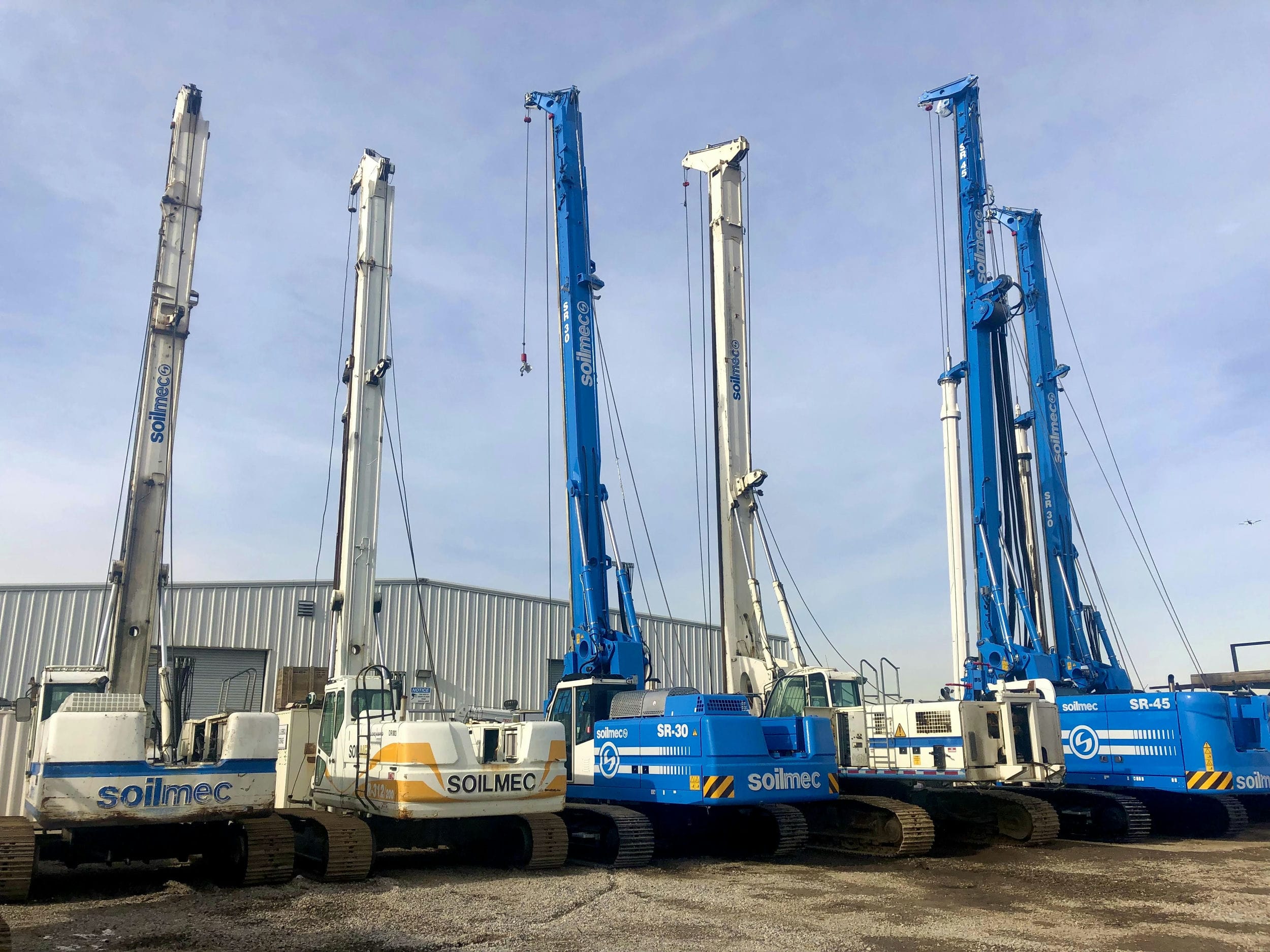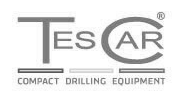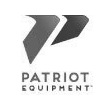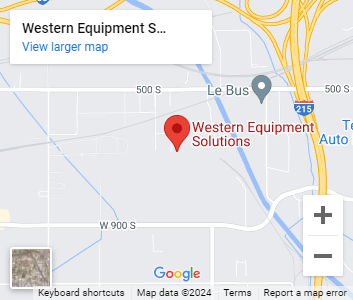Maintaining your foundation drilling equipment is a key factor to successfully completing jobs. Regular upkeep ensures your equipment functions effectively, remains safe, and avoids costly repair bills.
Today’s blog will walk you through the must-do equipment maintenance tasks. We’ll cover everything from the basic checks before you start working to how to clean and store your gear and decide when to fix something or get a new one. Plus, we’ll talk about why keeping good records of your maintenance work is super important.
This guide is great whether you’ve been in construction for years or are just starting. Understanding these maintenance tips will help keep your drilling equipment ready and reliable for any project.
PRE-OPERATIONAL CHECKS AND ROUTINE MAINTENANCE
Pre-operational checks happen before you start using your foundation drilling equipment. These checks help make sure that everything runs smoothly and safely. Here’s what you should do:
- Visual inspection: Check for any visible signs of wear, damage, or corrosion on the equipment. Inspect the mast, boom, and other structural components for cracks or deformities. Look for leaks in hydraulic lines and make sure all fittings are tight.
- Mechanical components check: Check the drill bits to see if they are sharp and not worn out. Replace teeth on augers to make them more efficient. Make sure the rotary drive, Kelly bar, and other drilling tools are working well and are in good shape. Look over the outriggers, stabilizers, and any equipment used to support the ground to ensure they work as they should. Fix or replace any piece of equipment that isn’t working right.
- Lubrication: Regularly lubricate all the moving parts, like bearings, joints, and pivot points, to lessen friction and wear. Also, check that the hydraulic and engine oil levels are within the suggested limits.
- Electrical systems: Inspect the battery, ensuring the connections are clean and tight. Check the control panel and operating controls for responsiveness and signs of electrical issues.
- Safety features: Check that emergency stop buttons or levers are working properly. Also, ensure that alarms, lights, and other warning systems function correctly.
- Fluids and filters: Make sure the hydraulic, engine and other fluid levels are correct. Clean or change the filters regularly to stop them from clogging and keep everything running smoothly.
- Housekeeping: Make sure the rig is free from debris, dirt, and too much oil or grease. Also, keep all tools and drilling accessories neat and properly put away.
CLEANING AND STORAGE: ESSENTIALS FOR EQUIPMENT CARE
It’s important to clean and store your foundation drilling equipment correctly. This keeps it working well and helps it last longer. Here are some steps to properly clean and store your equipment:
Cleaning Process
Remove debris and dirt
Start by removing any large debris or dirt from the equipment. Pay special attention to moving parts and joints where debris might accumulate and cause wear or damage. This especially includes any concrete that may be lodged in the drill rigs, hoses, and/or grout plants.
Wash the equipment
Use a pressure washer or hose to clean the equipment thoroughly. You’ll want to remove all traces of mud, dirt, and drilling fluids, as these will corrode metal parts over time.
Clean sensitive components carefully
When cleaning electrical parts, control panels, and hydraulic systems, use safe cleaning methods that don’t harm them. Usually, wiping them with a damp cloth and some gentle soap is enough for these parts.
Dry thoroughly
After washing, make sure the equipment is completely dry. Water left on metal surfaces leads to rust and corrosion. Use air hoses or dry cloths to remove excess water.
Inspect for wear or damage
While cleaning, inspect for any signs of wear or damage. Cleaning is an excellent opportunity to spot issues that might need repair.
Storage Guidelines
Indoor storage
Store the equipment in a covered, dry area to protect it from the elements. Indoor storage helps prevent rust and weather-related damage.
Proper positioning
Place the equipment so that no single part is under too much strain. Make sure to pull in the hydraulic arms and properly put away the stabilizers.
Protective coverings
If indoor storage isn’t available, use weather-resistant covers to protect the equipment from rain, snow, and sun.
Lubricate before storing
Apply a light coat of oil or lubricant to metal parts to prevent rust, especially if you’re storing the equipment for a long time.
Battery maintenance
If the equipment won’t be used for a while, disconnect and store the battery in a cool, dry place to prevent discharge and prolong its life.
Control rodent and pest access
Ensure that rodents or pests cannot access or damage the equipment. They can chew through wires, hoses, and other crucial components, so keeping them away is super important.
Regular check-ups
Even during storage, periodically check the equipment. Run it briefly if you can to keep moving parts lubricated and to identify any issues that may arise while it’s being stored.
By following these cleaning and storage protocols, you’ll ensure that your foundation drilling equipment remains in good working order, ready for use when needed, and free from long-term damage that neglect or environmental factors could cause.
MANAGING WEAR AND TEAR: REPLACEMENT AND REPAIR
Looking after your foundation drilling equipment and determining whether to fix or replace parts is important for keeping it working well and efficiently over time.
Wear And Tear
Regular inspections
Regularly check your equipment carefully. Pay special attention to parts that wear out quickly, like drill bits, bearings, hydraulic lines, and electrical systems. Catching wear and tear early helps stop bigger problems from happening later.
Follow the manufacturer’s maintenance schedule
Follow the maintenance schedule given by the equipment’s manufacturer. These schedules are set up to keep the equipment in the best condition and stop it from wearing out too much.
Use quality parts and fluids
Invest in high-quality replacement parts and fluids. Cheaper alternatives might save costs in the short term but often lead to more frequent failures and replacements.
Train operators and staff
Make sure all operators and maintenance workers are trained well. Using and handling the equipment correctly cuts down on extra wear and tear.
Immediately addressing issues
Fix any problems as soon as they come up. Ignoring them usually causes bigger issues down the line.
Repair Vs. Replacement
Cost analysis
Compare the cost of repairs with the cost of replacement. If the repair cost is close to or more than the replacement cost, it’s usually more cost-effective to replace it.
The equipment’s age and condition
Older equipment or parts repaired multiple times might be more prone to breakdowns, making replacement a more viable option.
How well is the equipment performing?
See if the worn or damaged part affects how well the equipment works. If fixing it brings it back to full performance, that might be enough. But if it’s still not working right, you might need to replace it.
Downtime considerations
Think about how much time you’ll lose whether you repair or replace the equipment. If fixing it takes a long time and delays your project, it might be better just to get a new one right away.
The availability of parts
If parts are difficult to obtain or have long lead times, it might be more practical to replace the equipment.
Future reliability
Consider the reliability of the equipment post-repair. Repairs may be worthwhile if they significantly extend the equipment’s life without further issues. However, if reliability is questionable, replacement might be the safer option.
Safety
Safety is paramount. If the integrity of a part or equipment is compromised to the point that it poses a safety risk, replacement is often best.
RECORD KEEPING AND MAINTENANCE LOGS
Keeping records and maintenance logs is important for managing your equipment well, especially with foundation drilling equipment. These logs help you keep an eye on the equipment’s condition, make sure it’s safe to use, control costs, and work as efficiently as you can.
Tracking Equipment Health
Maintenance logs help you schedule regular maintenance tasks, preventing minor issues from becoming more extensive, costlier problems. By keeping track of maintenance history, you can anticipate when service is due and plan accordingly.
Logs also allow you to identify patterns in wear and tear or recurring issues. This is crucial in diagnosing underlying problems that may not be immediately apparent.
Ensuring Safety
Doing regular maintenance and keeping precise records help ensure your equipment works safely. These records are often needed to show that you’re meeting safety rules and standards.
Also, equipment that’s kept in good shape is less likely to break down and lead to accidents. Maintenance logs give a detailed account of what you’ve done to maintain the equipment and keep it safe to use.
Cost Management
Accurate records help in forecasting maintenance costs and budgeting for repairs and replacements. This is essential for financial planning and avoiding unexpected expenses.
Operational Efficiency
Keeping up with regular maintenance and logging helps prevent sudden equipment failures, which means less time lost on the job. By recording all the details, you make sure the equipment is always running at its best, which helps your project go smoothly.
Writing down everything you do for maintenance is a key part of managing your equipment. It affects how safe the equipment is, how much it costs to run, how well it works, and whether it meets legal rules. For foundation drilling equipment, where it’s really important for things to be reliable and safe, good record-keeping and logging maintenance are absolutely necessary.
PARTNER WITH WESTERN EQUIPMENT SOLUTIONS TODAY.
Ready to take your construction projects to the next level with reliable, efficient foundation drilling equipment? Look no further than Western Equipment Solutions. Our range of top-quality drilling equipment is designed to meet all your construction needs, ensuring durability, safety, and efficiency on every job site.
Don’t compromise on the quality and performance of your equipment. Choose Western Equipment Solutions for tools that stand the test of time and help you deliver outstanding results.
Contact Western Equipment Solutions today to explore our selection and find the perfect equipment to power your next project. We have locations in Salt Lake City, Utah; Alberta, Canada; and Paramount, California. Your solution for dependable foundation drilling equipment is a click away from Western Equipment Solutions.













